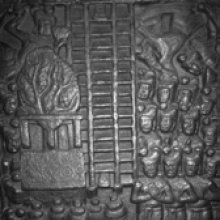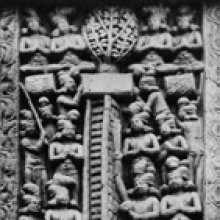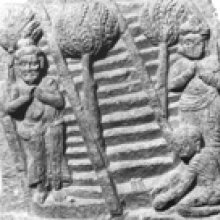Sankashya, Sāṅkāśyā, Sāṅkāśya: 3 definitions
Introduction:
Sankashya means something in Hinduism, Sanskrit. If you want to know the exact meaning, history, etymology or English translation of this term then check out the descriptions on this page. Add your comment or reference to a book if you want to contribute to this summary article.
The Sanskrit terms Sāṅkāśyā and Sāṅkāśya can be transliterated into English as Sankasya or Sankashya, using the IAST transliteration scheme (?).
Images (photo gallery)
In Hinduism
Purana and Itihasa (epic history)
Source: archive.org: Puranic EncyclopediaSāṅkāśya (साङ्काश्य).—A King of ancient days, who lived in Yama’s court. (Sabhā Parva, Chapter 8, Verse 10).
Source: Cologne Digital Sanskrit Dictionaries: The Purana IndexSāṅkāśyā (साङ्काश्या).—The capital of Kuśadhvaja;1 also the name of the kingdom.2

The Purana (पुराण, purāṇas) refers to Sanskrit literature preserving ancient India’s vast cultural history, including historical legends, religious ceremonies, various arts and sciences. The eighteen mahapuranas total over 400,000 shlokas (metrical couplets) and date to at least several centuries BCE.
Languages of India and abroad
Sanskrit dictionary
Source: Cologne Digital Sanskrit Dictionaries: Benfey Sanskrit-English DictionarySāṅkāśyā (साङ्काश्या).—i. e. saṃkāśa + ya, f. Name of a town, [Rāmāyaṇa] 1, 70, 3.
Sanskrit, also spelled संस्कृतम् (saṃskṛtam), is an ancient language of India commonly seen as the grandmother of the Indo-European language family (even English!). Closely allied with Prakrit and Pali, Sanskrit is more exhaustive in both grammar and terms and has the most extensive collection of literature in the world, greatly surpassing its sister-languages Greek and Latin.
See also (Relevant definitions)
Starts with: Sankashyapura.
Query error!
Full-text: Sankashyapura, Kushadhvaja, Sudhanva, Nya.
Relevant text
Search found 10 books and stories containing Sankashya, Sāṅkāśyā, Sankasya, Sāṅkāśya; (plurals include: Sankashyas, Sāṅkāśyās, Sankasyas, Sāṅkāśyas). You can also click to the full overview containing English textual excerpts. Below are direct links for the most relevant articles:
History of Indian Medicine (and Ayurveda) (by Shree Gulabkunverba Ayurvedic Society)
Chapter 15 - Kampilya as a Centre of Learning < [Part 4 - Some Aspects of Life in Caraka’s Times]
Tilakamanjari of Dhanapala (study) (by Shri N. M. Kansara)
3. Dhanapala’s Ancestry < [Chapter 1 - The Author (biography of Dhanapala)]
Introductory Verses < [Chapter 6 - Summary of the Tilakamanjari]
Ramayana (by Manmatha Nath Dutt)
A Historical Study of Kaushambi (by Nirja Sharma)
The Buddhist Tradition < [Chapter 2]
Ramayana of Valmiki (by Hari Prasad Shastri)
Chapter 71 - King Janaka gives an account of the succession and his dynasty < [Book 1 - Bala-kanda]
Mahabharata (English) (by Kisari Mohan Ganguli)
Section VIII < [Lokapala Sabhakhayana Parva]


